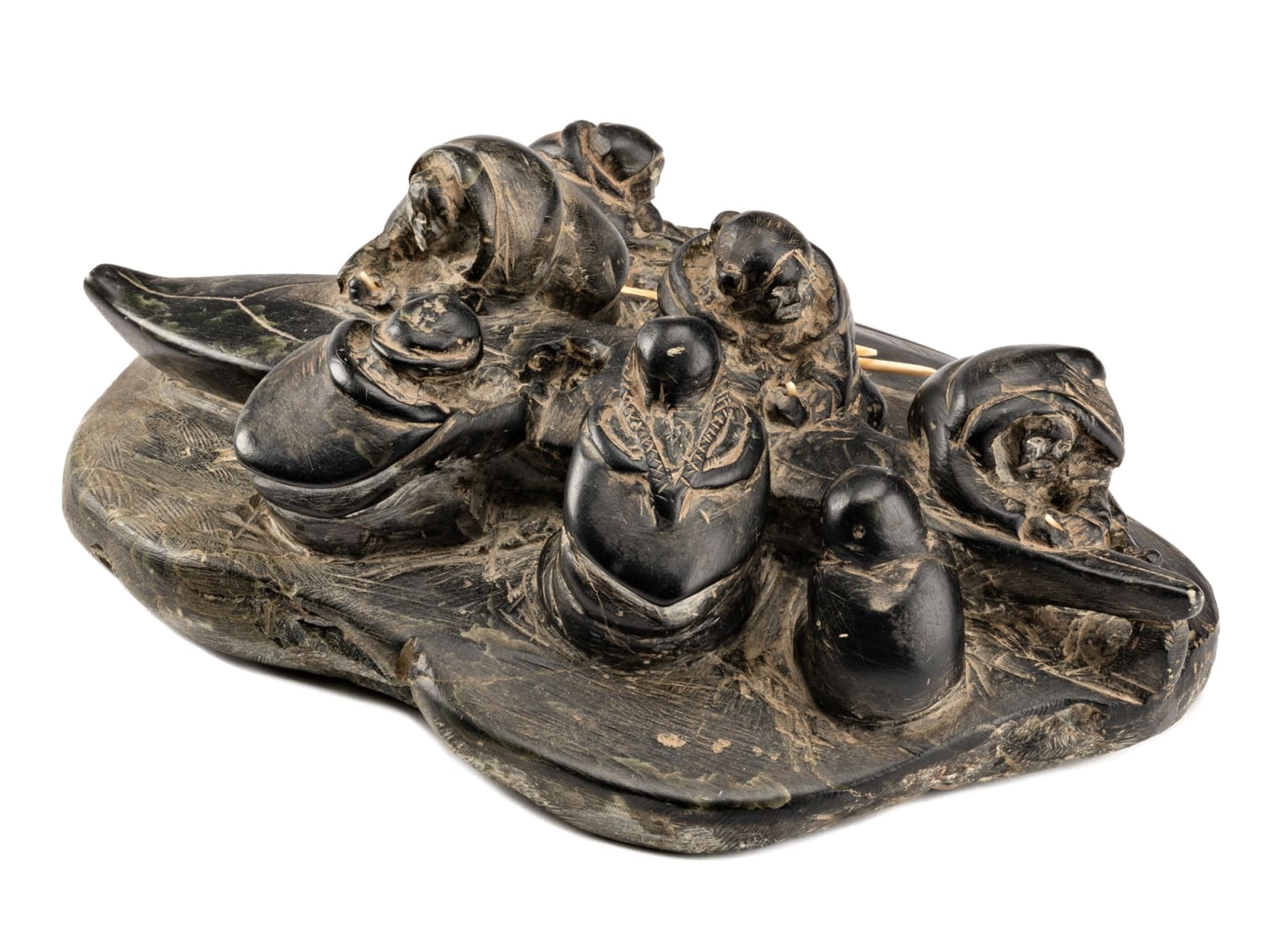-
Artworks
ENNUTSIAK (1893-1967) IQALUIT (FROBISHER BAY)
Women Making a Kayak, c. 1958-60stone and ivory, 3.5 x 10.25 x 7.5 in (8.9 x 26 x 19.1 cm)
signed and inscribed with artist's disc number, "ᐊᐱᓕ / ᐃᓄᓯᐊ / E7 / 603".LOT 134
ESTIMATE: $7,000 — $10,000
PRICE REALIZED: $8,400.00Further images
In much the same way that Peter Pitseolak (1902-1973) holds a special place as an Inuit artist, photographer, and historian (see Lot 161), we would argue that Ennutsiak also deserves...In much the same way that Peter Pitseolak (1902-1973) holds a special place as an Inuit artist, photographer, and historian (see Lot 161), we would argue that Ennutsiak also deserves credit for preserving in stone what Pitseolak was busy recording on film. The two artists lived contemporaneous lives in a world in rapid transition, and both felt compelled to record for posterity not only the rapidly disappearing “old way of living” but also the arrival of the “new.” Peter Pitseolak’s writings and interviews as well as his important archive of photos and negatives and even visual art have been well documented. Instead of leaving behind a cache of images and writings, Ennutsiak’s sculptures were scattered to the winds, with most of his pieces being sold directly to local and visiting qallunaat (Southerners) instead of via the established marketing system delivering works to the south. It is always a delight when previously unknown carvings by Ennutsiak come to the market, as they help us to better understand this remarkable artist and his marvelous body of work.
As previously discussed, (see lot 77) Ennutsiak concentrated primarily on scenes from traditional camp life. Some pieces depict individual family units but many of his most powerful pieces show the communal nature of camp life, where the collaboration of many people was required to complete important tasks. In this magnificent tableau of women at work, we see a group of six women diligently sewing skins together around a kayak frame. The skill of Inuit seamstresses and their ability to create waterproof joints had been passed down for centuries, and we wonder whether Ennutsiak was concerned that these skills might disappear in his lifetime.
This carving is truly a tour de force for Ennutsiak, fashioned from a single piece of stone with the rudimentary of tools. Each of the six seamstresses is lovingly rendered, and we sense that amongst the group are women of all ages, with the elderly illustrating skills and tips to the younger ones in the way that knowledge has always been traditionally passed from one generation to the next. (Note how one of the women glances over to watch her neighbour’s handiwork!) Outside the sewing circle sits a solitary man who concentrates on fabricating the paa (cockpit rim) to be attached to the top of the frame. Carved in an age where kayaks were being replaced by motorboats, this piece is a poignant reminder of the past.
References: For important works by the artist see First Arts Auction, May 2019, Lot 40; 14 June 2022, Lot 8; Gerald McMaster, ed., Inuit Modern: The Samuel and Esther Sarick Collection, (Toronto: Art Gallery of Ontario, 2010), p. 83; Bernadette Driscoll, Baffin Island, (Winnipeg: Winnipeg Art Gallery, 1983), cats. 30-33; Bernadette Driscoll, The Inuit Amautik: I Like my Hood to be Full, (Winnipeg: Winnipeg Art Gallery, 1980), cat. 20, p. 62; Winnipeg Art Gallery, The Mulders’ Collection, (Winnipeg: Winnipeg Art Gallery, 1976), cat. 85; Maria von Finckenstein ed., Celebrating Inuit Art 1948-1970, (Gatineau: Canadian Museum of Civilization, 1999), p. 131-133; George Swinton, Sculpture of the Inuit, (Toronto: McClelland & Stewart, 1972/92), fig. 45, p. 26. For a wonderful contemporaneous graphic on the same subject see Lot 93 in our July 12, 2020 sale: Kiakshuk’s Singing Women Sew Kayak from the 1960 Cape Dorset annual print collection.Provenance
Private Collection, Montreal.
Join our mailing list
* denotes required fields
We will process the personal data you have supplied in accordance with our privacy policy (available on request). You can unsubscribe or change your preferences at any time by clicking the link in our emails.










